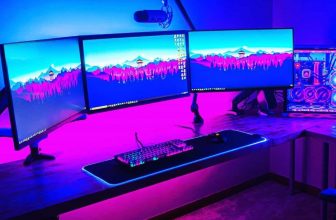IPS monitors are well-known for their superior colors and huge viewing angles. It is possible to enjoy the screen at any angle without having to worry about changing colors. In the past, even the most powerful IPS monitors weren’t thought of to be suitable for gaming. They had a slow response time. However, with the advancement of technology, changes have taken place. Nowadays, the best IPS monitors are ideal for gaming because they have high color contrast as well as fast response times.
However, selecting the right product isn’t easy due to the vast array of options available. In this area, we’ve selected the top IPS monitors for general use and gaming. First, we need to be aware of what is the best IPS monitor. Let’s get into the specifics.
How to Choose the Most Effective IPS Monitor ?
Before we look at the top IPS monitors, we’ll find out the criteria to select a top-quality one. These are the things to look for prior to purchasing:
- Resolution
- Graphics Card
- Refresh Rate
- Input Lag
- G-Sync And FreeSync
- Flicker Free
- Customization
- Screen Size
5 Best IPS Monitors To Go For
| Ranking | Best IPS Monitors | Reviews |
| 1 | ASUS ProArt Display PA278CV | 5 out of 5 |
| 2 | LG OLED 48C1 | 5 out of 5 |
| 3 | Samsung LC32G75TQSNXZA | 4 out of 5 |
| 4 | ASUS VG279Q | 3 out of 5 |
| 5 | BenQ GW2480 | 3 out of 5 |
5 Best IPS Monitors: A Detailed Look
We’ve tried over 300 monitors. Below are our recommendations of the best monitors that are available to purchase.
1. ASUS ProArt Display PA278CV
ASUS ProArt Display PA278CV
2. 61.49 x 38.2 x 22.61 cm
3. Mini DisplayPort 1.2
It’s an excellent general monitor. It’s the 2021 upgrade for the ASUS ProArt Display PA278QV. Although it functions largely in the same way, it does have some additional features. Similar to other monitors in the ProArt series, this is specifically designed for creators of content and media professionals. This means it covers the sRGB color spectrum and decent Adobe RGB coverage.
It’s also flexible, with a large monitor and 1440-pixel resolution, which is perfect for gaming, productivity, or even multimedia. It’s sufficient brightness to ward off the glare, and has excellent reflection management, and offers excellent ergonomics. If you are playing in the background it offers a 75Hz of refresh rate, an impressive response time, and minimal input delay. It is also compatible with the Adaptive-Sync variable refresh rate (VRR) to decrease the tearing of screens.
2. LG OLED 48C1
It’s the LG 48 C1 OLED TV which we’ve tested as a monitor. It replaces it with the LG 48 CX OLED in 2020. It offers a range of different options compared to normal monitors. It’s got a huge 48-inch screen, but that’s a sign that it has lower pixel density. This in combination with its distinctive WBGR subpixel display, the text clarity isn’t the greatest. This is advertised as being a game monitor and comes with features that gamers would appreciate. It’s a 120Hz display equipped with FreeSync Variable Refresh Rate (VRR) support & G-SYNC compatibility.
The device has four HDMI 2.1 connections, meaning that you can play games in 4K at up to 120 frames per second. If you own a compatible graphics card, it does not have a DisplayPort input. Its OLED panel has the ability to shut off individual pixels, which results in a nearly infinite contrast ratio, and flawless black uniformity. But, OLEDs are susceptible to burning-in & could cause problems with constant exposure to UI elements. We recommend using a screensaver, the taskbar hidden, and watching a variety of content when you intend to use it solely for a display.
3. Samsung LC32G75TQSNXZA
The Samsung Odyssey LCD32G75T is an extremely responsive gaming monitor. Samsung offers this monitor as part of its 2020 Odyssey gaming line, and it’s among the monitors that come in varied sizes: 27 inches & 32 inches. We tested both sizes. It has a 120Hz refresh rate, and comes with its native VRR support that helps reduce the screen’s tear. It’s also compatible with G-SYNC should you wish to pair it with the NVIDIA graphic card.
The resolution 1440p allows for crisp images without being overly demanding for your graphic card. This is a solid monitor that has an extremely curved 1000R screen which might not be for everyone’s taste. The VA panel makes it a good gaming monitor in dark environments.
4. ASUS VG279Q
ASUS VG279Q is among the 27″ monitors that offer the 1080p resolution and 144 Hz. The specs are available within TN as well as VA panels most of the time. If you’re searching for a display with clear colors and great viewing angles , then this might be a great option.
With a response time of just 3ms, this display provides an extremely smooth gaming experience. Additionally, you can enjoy an image that resembles a CRT when you set the resolution at 85Hz, 100Hz, or 120Hz. This is made possible by a technology known as ELMB, the backlighting technology. It features a peak of 400-nit brightness and an 8-bit color depth for outstanding image quality. However, the pixel density may be somewhat low in this model due to the fact that it’s a 1080p model.
A low framerate compensation feature is another benefit of this stunning camera. It delivers a smooth experience of up to 40 frames every second. The adaptive sync function permits users to utilize the AMD graphics card which operates with 40-144/FPS. It assists in removing screen tears and stutter out of the image.
We Believe you are a Gaming Enthusiast, You Might like Best 1440p 144hz Monitors
5. Razer HuntsmBenQ GW2480
This one is the probably best IPS monitor under budget that you can get. It’s a 24” 1080p eyecare monitor which is suitable for all kinds of users. It offers a full HD display (1980×1080) resolution with a pixel density of 23.8 inches. The GW2480 monitor is a color monitor with 8 bits system (6 bit plus 2 bits FRC). FRC can be described as the frame rate control of a display that shows great color schemes, even with low resolutions.
The monitor has the typical sRGB color gamut, which is an added benefit. It features an Advanced High-Performance IPS panel system (AH-IPS). It has a nit peak brightness of 250, and a 60 Hz refresh rate, and an optimum contrast ratio of 1000:1. With a response time of 5ms and an input delay of 10ms, this monitor guarantees no delay. You can boost the speed of response by setting your AMA option to High or Premium. The AMA (Advanced Motion Acceleration) can be utilized to reduce time delays and increase output.
Closing Note
You can also increase the speed of the system to up to 75 Hz to improve the clarity of motion. There’s also a built-in sensor in the monitor, which adjusts the brightness in accordance with the lighting conditions. So, your eyes will not be fatigued even after hours of prolonged usage.
These recommendations are based on our opinion of the most effective IPS monitors. These suggestions have been modified to be applicable to all price ranges. Our review considers price and feedback from our customers. Do not get bogged down in the finer details. Most monitors are sufficient for the majority of people. What monitors cannot achieve aren’t typically noticed unless they’re actually present. Good luck in your selection!!
Frequently Asked Questions (FAQs)
Q1. Does IPS work well for monitors?
IPS monitors are incredibly good for colors and wide viewing angles. They all claim to provide the most important benefits that come with the best IPS monitors: amazing color and super-wide viewing angles. In terms of accuracy of a color, it surpasses the performance of TN & VA monitors easily.
Q2. Is IPS safe for the eyes?
Contrary to other kinds of panels, the liquid crystals inside Best IPS monitors are shifted horizontally in order to give superior viewing angles, outstanding image quality and color precision. In IPS monitors, you’ll be able to get super-wide viewing angles as well as stunning color.
Q3. Is it possible to fix the IPS glow?
IPS glow is described as visible glowing on the corners on the IPS display panel. It’s a normal negative aspect of IPS technology. It is possible to reduce it by the addition of ambient lighting to your space, which can reduce the brightness of your monitor, and altering the angle and distance that you’re looking at.
Q4. Which is better, OLED or IPS?
OLEDs have better contrast: They emit light, and can be completely shut off providing a good contrast. OLEDs have more viewing angles. IPS LCDs have great viewing angles, but OLED TVs are superior in this aspect.















